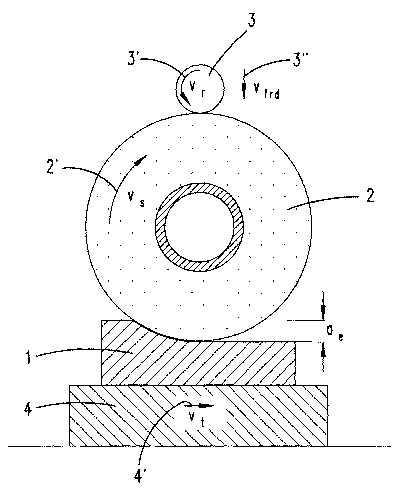Some of the information on this Web page has been provided by external sources. The Government of Canada is not responsible for the accuracy, reliability or currency of the information supplied by external sources. Users wishing to rely upon this information should consult directly with the source of the information. Content provided by external sources is not subject to official languages, privacy and accessibility requirements.
Any discrepancies in the text and image of the Claims and Abstract are due to differing posting times. Text of the Claims and Abstract are posted:
| (12) Patent Application: | (11) CA 2408434 |
|---|---|
| (54) English Title: | METHOD FOR GRINDING METALLIC WORKPIECES CONTAINING, IN PARTICULAR, NICKEL |
| (54) French Title: | PROCEDE POUR MEULER DES PIECES METALLIQUES CONTENANT NOTAMMENT DU NICKEL |
| Status: | Deemed Abandoned and Beyond the Period of Reinstatement - Pending Response to Notice of Disregarded Communication |
| (51) International Patent Classification (IPC): |
|
|---|---|
| (72) Inventors : |
|
| (73) Owners : |
|
| (71) Applicants : |
|
| (74) Agent: | BLAKE, CASSELS & GRAYDON LLP |
| (74) Associate agent: | |
| (45) Issued: | |
| (86) PCT Filing Date: | 2001-04-21 |
| (87) Open to Public Inspection: | 2002-11-07 |
| Availability of licence: | N/A |
| Dedicated to the Public: | N/A |
| (25) Language of filing: | English |
| Patent Cooperation Treaty (PCT): | Yes |
|---|---|
| (86) PCT Filing Number: | PCT/EP2001/004529 |
| (87) International Publication Number: | WO 2001089766 |
| (85) National Entry: | 2002-11-07 |
| (30) Application Priority Data: | ||||||
|---|---|---|---|---|---|---|
|
The invention relates to a method for grinding metallic workpieces containing,
in particular, nickel, whereby a rotationally driven grinding wheel (2) is
continuously dressed by a rotationally driven dressing wheel (3) during the
grinding of the workpiece (1) by the continual advance (vfrd) of the dressing
wheel. In order to increase the grinding capacity, the invention provides that
with a dressing advance velocity of 1 to 2 µm per rotation of the grinding
wheel and with a circumferential velocity of the grinding wheel (vs) of at
least 45 m/s, the advance (table velocity vt) is set such that the rate of
metal removal is at least 90 mm3/mms.
L'invention concerne un procédé permettant de meuler des pièces métalliques contenant notamment du nickel, selon lequel une meule (2) entraînée en rotation, d'une roue de dressage (3) entraînée en rotation est dressée en continu pendant le meulage d'une pièce (1), par approche continue (cfrd) de la roue de dressage. Afin d'augmenter la capacité de meulage, il est prévu d'ajuster l'avance, pour une vitesse d'approche de dressage allant de 1 à 2 µm par rotation de la meule et pour une vitesse périphérique de la meule (vs) d'au moins 45 m/s, de sorte que le taux d'enlèvement de copeaux soit d'au moins 90 mm?3¿/mms.
Note: Claims are shown in the official language in which they were submitted.
Note: Descriptions are shown in the official language in which they were submitted.

2024-08-01:As part of the Next Generation Patents (NGP) transition, the Canadian Patents Database (CPD) now contains a more detailed Event History, which replicates the Event Log of our new back-office solution.
Please note that "Inactive:" events refers to events no longer in use in our new back-office solution.
For a clearer understanding of the status of the application/patent presented on this page, the site Disclaimer , as well as the definitions for Patent , Event History , Maintenance Fee and Payment History should be consulted.
| Description | Date |
|---|---|
| Time Limit for Reversal Expired | 2007-04-23 |
| Application Not Reinstated by Deadline | 2007-04-23 |
| Deemed Abandoned - Failure to Respond to Maintenance Fee Notice | 2006-04-21 |
| Inactive: Abandon-RFE+Late fee unpaid-Correspondence sent | 2006-04-21 |
| Appointment of Agent Requirements Determined Compliant | 2005-04-13 |
| Inactive: Office letter | 2005-04-13 |
| Revocation of Agent Requirements Determined Compliant | 2005-04-13 |
| Inactive: Office letter | 2005-04-11 |
| Revocation of Agent Request | 2005-03-17 |
| Appointment of Agent Request | 2005-03-17 |
| Inactive: Agents merged | 2003-02-10 |
| Inactive: Cover page published | 2003-02-10 |
| Letter Sent | 2003-02-06 |
| Inactive: Notice - National entry - No RFE | 2003-02-06 |
| Application Received - PCT | 2002-12-04 |
| Application Published (Open to Public Inspection) | 2002-11-07 |
| National Entry Requirements Determined Compliant | 2002-11-07 |
| Abandonment Date | Reason | Reinstatement Date |
|---|---|---|
| 2006-04-21 |
The last payment was received on 2005-03-17
Note : If the full payment has not been received on or before the date indicated, a further fee may be required which may be one of the following
Patent fees are adjusted on the 1st of January every year. The amounts above are the current amounts if received by December 31 of the current year.
Please refer to the CIPO
Patent Fees
web page to see all current fee amounts.
| Fee Type | Anniversary Year | Due Date | Paid Date |
|---|---|---|---|
| Basic national fee - standard | 2002-11-07 | ||
| MF (application, 2nd anniv.) - standard | 02 | 2003-04-22 | 2002-11-07 |
| Registration of a document | 2002-11-07 | ||
| MF (application, 3rd anniv.) - standard | 03 | 2004-04-21 | 2004-02-09 |
| MF (application, 4th anniv.) - standard | 04 | 2005-04-21 | 2005-03-17 |
Note: Records showing the ownership history in alphabetical order.
| Current Owners on Record |
|---|
| TYROLIT-SCHLEIFMITTELWERKE SWAROVSKI K.G. |
| Past Owners on Record |
|---|
| ANDREAS PASKUDA |
| HARALD KULMITZER |
| ROBERT SCHLECHTER |